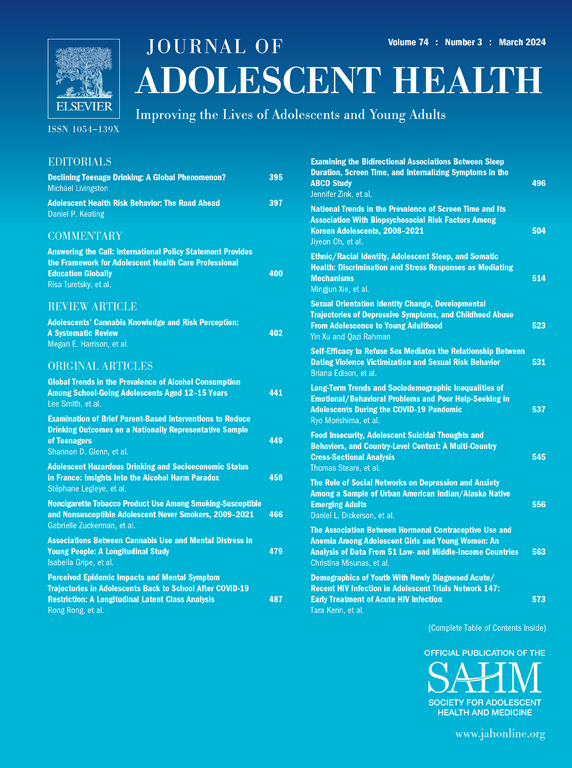Physical Activity by Accelerometry is Prospectively Associated With Lower Testosterone and Hirsutism Score Among Adolescent Girls
IF 5.5
2区 医学
Q1 PEDIATRICS
引用次数: 0
Abstract
Purpose
Physical activity (PA) is recommended for the management of women with polycystic ovary syndrome (PCOS). However, it is not known whether PA modulates the risk of components of PCOS diagnostic criteria during adolescence.
Methods
We included participants from the Avon Longitudinal Study of Parents and Children prospective cohort with objective measurement of PA and sedentary behavior using accelerometry between ages 11 and 15 years, biochemical and clinical measures of hyperandrogenism (serum total testosterone level at 15 years and self-reported hirsutism at 19 years), and self-reported menstrual regularity at 17 years. Two-stage regression models evaluated the association of repeated measures of PA and sedentary behavior with components of PCOS diagnostic criteria.
Results
Among 1,526 singleton girls with accelerometer data and testosterone samples, time spent in light PA was inversely associated with total testosterone (ß = −0.070, 95% CI −0.114, −0.025; nmol/L, per 60 minutes) and continuous hirsutism score (ß = −0.756, 95% CI −1.41, −0.103; per 60 minutes). Conversely, time spent sedentary was associated with higher total testosterone level (ß = 0.052, 95% CI 0.013, 0.090; per 60 minutes) and hirsutism score (ß = 0.668, 95% CI 0.103, 1.23; per 60 minutes). Associations were independent of adiposity, but results for hirsutism were attenuated following adjustment for age at menarche and after stratification by hormonal contraceptive use. No associations were observed with menstrual irregularity, for other PA intensity components, or among users of hormonal contraceptives.
Discussion
More time spent in light intensity physical activity and less time spent sedentary during early adolescence is associated with lower testosterone concentrations and lower hirsutism scores in late adolescence.
通过加速度计进行的体育活动与青春期女孩睾酮和多毛症评分较低有关
目的:体育锻炼(PA)是治疗多囊卵巢综合征(PCOS)的首选方法。然而,目前尚不清楚PA是否会调节青春期PCOS诊断标准的风险。方法我们纳入了来自雅芳父母和儿童纵向研究前瞻性队列的参与者,使用加速度计客观测量11至15岁之间的PA和久坐行为,生化和临床测量高雄激素症(15岁时血清总睾酮水平和19岁时自我报告的多毛),以及17岁时自我报告的月经规律。两阶段回归模型评估了反复测量PA和久坐行为与PCOS诊断标准组成部分的关系。结果在1526名有加速度计数据和睾酮样本的单身女孩中,轻度PA时间与总睾酮呈负相关(β = - 0.070, 95% CI - 0.114, - 0.025;nmol/L,每60分钟)和持续多毛评分(ß =−0.756,95% CI−1.41,−0.103;每60分钟)。相反,久坐时间与较高的总睾酮水平相关(ß = 0.052, 95% CI 0.013, 0.090;每60分钟)和多毛症评分(ß = 0.668, 95% CI 0.103, 1.23;每60分钟)。相关性与肥胖无关,但在调整初潮年龄和使用激素避孕药分层后,多毛症的结果减弱。未观察到与月经不规律、其他PA强度成分或激素避孕药使用者之间的关联。在青春期早期,花更多的时间进行低强度的体育活动,而较少的时间坐着不动,这与青春期后期较低的睾丸激素浓度和较低的多毛症得分有关。
本文章由计算机程序翻译,如有差异,请以英文原文为准。
求助全文
约1分钟内获得全文
求助全文
来源期刊

Journal of Adolescent Health
医学-公共卫生、环境卫生与职业卫生
CiteScore
10.40
自引率
3.90%
发文量
526
审稿时长
46 days
期刊介绍:
The Journal of Adolescent Health is a scientific publication dedicated to enhancing the health and well-being of adolescents and young adults. Our Journal covers a broad range of research topics, spanning from the basic biological and behavioral sciences to public health and policy. We welcome a variety of contributions, including original research papers, concise reports, literature reviews, clinical case reports, opinion pieces, and letters to the editor. We encourage professionals from diverse disciplines such as Anthropology, Education, Ethics, Global Health, Health Services Research, Law, Medicine, Mental and Behavioral Health, Nursing, Nutrition, Psychology, Public Health and Policy, Social Work, Sociology, and Youth Development to share their expertise and contribute to our mission of promoting adolescent health. Moreover, we value the voices of young individuals, family and community members, and healthcare professionals, and encourage them to submit poetry, personal narratives, images, and other creative works that provide unique insights into the experiences of adolescents and young adults. By combining scientific peer-reviewed research with creative expressions, our Journal aims to create a comprehensive understanding of the challenges and opportunities in adolescent and young adult health.
 求助内容:
求助内容: 应助结果提醒方式:
应助结果提醒方式:


